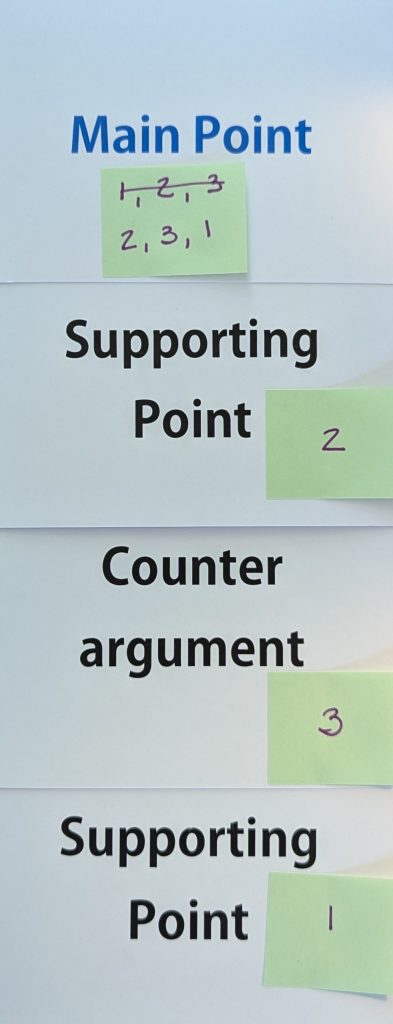Drafting 1: Setting Up Your Structure
 At some point in your writing, you will need to think about the order of your ideas. There is no “right” time to do structural work on your writing, but it must be done.
At some point in your writing, you will need to think about the order of your ideas. There is no “right” time to do structural work on your writing, but it must be done.
For some writers and some projects, organization happens very early in the process. For example, I tend to write out a kind of rough outline of any long project (like this text) before I generate the content for those sections. For other writers and other projects, this happens later, after some text has been written. I know writers who spend a lot of time freewriting their ideas first and then organizing those ideas afterward.
There are two parts to the organization of academic writing: overall organization and the thesis statement. This section talks about both. I discuss the overall organization first because we frequently don’t have a good handle on what our thesis is going to be until we’ve started to organize our ideas. However, there’s nothing wrong with developing your working thesis at any point in the process.
Creating a Logical Organization
You are almost certainly familiar with the five-paragraph theme. In your opening paragraph, you introduce your topic, and your thesis makes three points about that topic. In the body of your paper, you explain those three points, each in its own paragraph. In the conclusion, you sum up what you just wrote.
This format has probably served you well on exams and standardized tests, and it still can—sometimes. This ready-made structure focuses on clarity and simplicity, which is why it works in testing situations, for example. However, most of the writing you will do in college is more complex, asking you to make more sophisticated connections among ideas. The five-paragraph theme isn’t up to this kind of complexity.
So, if you aren’t using a five-paragraph theme, what do you do instead?
Focusing on Your Reader
Most importantly, think about your reader. What does your reader need to understand first? What do they need to understand after that? And after that? If you focus on what your reader needs to know and when they need to know it, you are likely to end up with an essay that works logically.
When you focus on your reader, your organization tends to grow organically out of your topic. Put yourself in your audience’s shoes and imagine their experience reading your work. Try anticipating their questions and challenges. Ideally, you want to address those as close as possible to the moment they would occur during the reading experience.
Something else to keep in mind: We remember best what we read last. This means that, most of the time, your most important point should occur late in your essay. You’ll definitely want to highlight this point in your conclusion, but you’ll also want to try to put the details of that point late in your paper, perhaps just before your conclusion, if you can.
Using Standard Structures, as Needed
 Some common organizational approaches can also help you think about ways to order your ideas. These should not be used in place of anticipating your reader, but they can be used to help you think about ways to make your logic easier to follow.
Some common organizational approaches can also help you think about ways to order your ideas. These should not be used in place of anticipating your reader, but they can be used to help you think about ways to make your logic easier to follow.
Chronological or Sequential Order
When time is important for understanding your point, put first things first and last things last. This kind of order appears frequently in narratives, both full-essay narratives and anecdotes that appear in part of an essay. This order is also useful for explaining processes or historical developments.
Spatial Order
When place is a central feature of your writing, move your reader through that space in a logical way: top to bottom, bottom to top, east to west, west to east, etc. This order is used most frequently in descriptions of locations, but it can also work to explain visuals.
Climactic Order
When you have a series of points that are increasingly important, explain the least important first and progressively move through your points until you get to the most important. This kind of order can be helpful when you need to order a set of similar ideas, such as causes or effects of a problem.
Problem/Solution
When you are trying to propose a solution, you have to explain the problem before any explanation of a solution will make sense. This structure appears frequently in proposals and arguments. Note that the two parts do not necessarily get equal weight in a piece of writing. If the reader is already very familiar with the problem, there is no point belaboring it. If the problem is unfamiliar, the reader will need much more explanation, and you may not get to spend as much time on the solution.
Comparison/Contrast
 When you need to address similarities and/or differences, you can organize your ideas either (1) point-by-point, where you alternate between the two things you are comparing or (2) in two main sections, where you explain all about one of the things you are comparing first and then the other. The second approach can also be structured so that you are explaining all of the similarities together and then all of the differences (or differences then similarities, depending on what you want to emphasize).
When you need to address similarities and/or differences, you can organize your ideas either (1) point-by-point, where you alternate between the two things you are comparing or (2) in two main sections, where you explain all about one of the things you are comparing first and then the other. The second approach can also be structured so that you are explaining all of the similarities together and then all of the differences (or differences then similarities, depending on what you want to emphasize).
Sometimes, you will run into conventional structures, organizational patterns for texts that have become routine and expected by readers. Usually, your instructor will make clear when you should use a structure like this.
Here are two examples:
IMRD or IMRaD (pronounced as a word: im-RAD)
IMRD is a standard structure for research reporting in many fields, including most natural and social sciences. The initials stand for Introduction, Method, Results, Discussion, and each part serves a specific purpose. You’ve probably already used a version of this in lab reports, and often professors will give you specific instructions about what to include in each part.
Grants or Project Proposals
Grant or project proposals are written in many fields, from business to science to education. They often include many of the same sections: an executive summary, an introduction of the person or organization writing the proposal, a problem statement, a statement of goals and objectives, an explanation of the project design, an evaluation section, and a section on other funding sources and the budget request of the proposal. The specific sections and the order of those sections will almost always be provided by the funding or supervising organization, but the parts are fairly regular.
Writing a Working Outline
It can be helpful to draft a list of the ideas that you know you need to cover and the order in which you plan to cover them. If you draft this kind of outline, you can use it as a guide while you are generating your own writing, moving about in your paper so that you keep your ideas flowing.
For instance, while I was drafting this section, I started by writing a working list of topics. As I started writing in each section, I would sometimes divide up the topic, and sometimes I would move sections around as I thought about what you would need to read and when you would need to read it. I also jumped around as I wrote, writing in different sections as ideas came to me.
The section you are reading wasn’t originally in this part of the text. I thought I would talk about this in the Getting Words Out section, when I planned to talk about ways to keep yourself writing. However, I realized that ending the Logical Organization section on formal structures would send the message that formal structures are the most important part of organizing your ideas. Instead, I realized that I wanted to focus on what you can do with a working structure, so I moved that section to here.
Writing a Working Thesis
 A thesis statement is an explanation of the key point in a piece of writing. For relatively short pieces (roughly 1500 words or fewer), it is usually only one sentence. For longer pieces, it may take two or three sentences to explain, and in very long pieces (like a master's thesis or dissertation), these can take paragraphs or even a full chapter.
A thesis statement is an explanation of the key point in a piece of writing. For relatively short pieces (roughly 1500 words or fewer), it is usually only one sentence. For longer pieces, it may take two or three sentences to explain, and in very long pieces (like a master's thesis or dissertation), these can take paragraphs or even a full chapter.
No matter the length, if your reader reads nothing else, they should be able to identify your topic and your main idea from reading your thesis statement alone.
Academic writing almost always has a thesis statement, but not all writing does. You may or may not find thesis statements in personal essays and magazine stories. You probably won’t find them in works of fiction.
Characteristics of a Good Thesis
Good thesis statements have a number of qualities:
- They make claims that are arguable.
- They are specific.
- They give your reader some sense of your reasoning.
- They do not express mere preference.
- They make statements; they do not ask questions.
Let’s talk about each of these for a minute.
Arguable Claims
 A thesis makes a claim that reasonable people might disagree with. This is true whether you are writing a position statement (which, by definition, makes a clear claim about an arguable issue) or whether you are writing a report, which is more focused on objective presentation of information.
A thesis makes a claim that reasonable people might disagree with. This is true whether you are writing a position statement (which, by definition, makes a clear claim about an arguable issue) or whether you are writing a report, which is more focused on objective presentation of information.
In the case of the position statement, the idea of an arguable claim is fairly obvious. For example, “The United States should take in more refugees” is obviously a claim that not everyone agrees with.
But what about a thesis such as “Refugees require substantial resources from the countries that they enter”? This seems fairly obvious, but it is still arguable. An opponent could claim that the resources are relatively small, not substantial, even if they want to talk about the same resources that an opponent would discuss (e.g., food, clothing, and shelter).
A thesis is not a statement of fact. The statement “Refugees leave their home countries because of war, personal danger, and natural disasters” is really just a definition, and so there is nothing to argue here. There is no sense of “so what?” in this statement.
“Reasonable People”
Specific Claims
Thesis statements make specific claims, not vague statements. A claim such as “It is important for the United States to take in refugees” is a weak thesis because it relies on the word “important,” which can have almost as many definitions as there are readers. Look for other abstract words and phrases, such as “good,” “bad,” “things,” “important,” and “a lot” in your thesis statement. If you see those, try to find ways to be more specific about what you mean.
Similarly, look for places where you want to use “etc.” or “and so on” (or other phrases like this). These signal a list that extends beyond what you have written. While these appear sometimes in academic writing, when they appear in your thesis statement, you are signaling that you couldn’t be bothered to group ideas from a long list. As a result, your reader can’t determine what you are actually going to talk about and what you are going to leave out. Your thesis statement should be more definite than that.
Reasoning
 Your reader wants to know a bit about why you think what you do in your thesis. Let’s take the claim “The United States should take in more refugees.” If you stop there, your reader immediately thinks, “Why?” Giving your reader some sense of your answer to that question in your thesis will strengthen the opening of your text.
Your reader wants to know a bit about why you think what you do in your thesis. Let’s take the claim “The United States should take in more refugees.” If you stop there, your reader immediately thinks, “Why?” Giving your reader some sense of your answer to that question in your thesis will strengthen the opening of your text.
Notice that providing some sense of reasoning can also help make your thesis more specific. For example, with the thesis statement “It is important for the United States to take in refugees,” as soon as you add “because” and then at least one reason, your thesis not only presents your reasoning, but it also becomes more specific.
Not Mere Preference
Thesis statements must do more than express personal preference. When I say “I like the addition of refugees to my community,” I’m not making an arguable claim because you can’t tell me that I don’t like something.
These kinds of claims don’t necessarily require the first person (“I” or “my”). Saying that “Chocolate is the best flavor” is also a statement of personal preference, as many students and my family have explained to me over the years. In this case, though, it’s OK because it means that I get more chocolate.
Not Questions
Sometimes, students want to ask questions to lead into the rest of their paper. While that can work, those questions cannot serve as a thesis statement because your reader needs to know what you are claiming. “Why should the United States allow in more refugees?” doesn’t provide your reader with any sense of your claim (do you think that it’s a good idea or not?) and doesn’t provide any reasoning. This leaves your reader with too many questions.
Remember that your reader should be able to read just your thesis statement and understand the gist of your paper. A question cannot do that work.
For each of the following thesis statements, indicate whether it is a good working thesis and if not, why it isn’t.
- Recreational marijuana is legal in more than ten states.
- How does a state decide that making recreational marijuana legal is a good idea?
- Legalizing recreational marijuana is a smart choice for states because it provides additional revenue for state and local governments.
- Legalizing recreational marijuana makes sense.
- Legalizing recreational marijuana will make it easier for minors to start using this drug, leading to increased use and use of harder drugs later in life.
- Legalizing recreational marijuana poses interesting problems for politicians.
Placing Your Thesis
The thesis statement usually appears at the end of the introduction, which is where your audience is expecting you to transition from introducing your topic to explaining your points about that topic.
However, this isn’t a hard-and-fast rule. In some cases, the thesis works well as an opening sentence. In some pieces, like lab or research reports, the thesis presents the key finding of the study, but it may not appear in the introduction at all. And if you are writing to a hostile audience (one that opposes your ideas), it can be wise to save the thesis for your conclusion. However, normally, your thesis will make the most sense to your reader at the end of your introduction.
Using Your Thesis to Guide Your Structure
 Remember that your thesis is part of the structure of your paper. In addition to introducing your topic and claim, your thesis statement gives your reader some indication of the points you will cover and the order in which you will cover them.
Remember that your thesis is part of the structure of your paper. In addition to introducing your topic and claim, your thesis statement gives your reader some indication of the points you will cover and the order in which you will cover them.
Sometimes the order is obvious, as in the thesis for a five-paragraph theme. If you tell your reader that “The reasons to accept refugees include contributions to the economy, cultural enrichment, and moral decency,” but you begin with cultural enrichment, your reader will likely be confused. You said that you were going to talk about economic benefits and you indicated that that reason would be first by its placement in your thesis statement.
But even in more sophisticated thesis statements that avoid listing, there is an implied order. For example, let’s say your working thesis is “Safety concerns make it necessary for countries hosting refugees to thoroughly investigate people coming from hostile nations.” There is an implied order in that statement:
- First, you’re going to talk about safety concerns regarding refugees.
- Then, you’re going to talk about the investigations that are necessary.
- Then you’re going to talk about why this is particularly important for people coming from hostile nations.
But let’s rearrange this statement a bit: “When countries host refugees from hostile countries, they must investigate those refugees to allay safety concerns.” Here’s the implied order in this statement:
- First, you’re going to talk about the situation in which countries host refugees from hostile countries.
- Then you are going to talk about the investigations that are necessary.
- Finally, you are going to talk about how those investigations help people in the hosting country feel safer.
Don’t be afraid to play around with the order of your working thesis statement.
Using a thesis statement that you are currently working on, try reordering the parts of that statement. Even if you cannot come up with the wording you want to do, identify the pieces you plan to cover in your paper and move those around. Try to come up with at least two different structures.
Then, think about your options. Which order do you like better? Specifically, try thinking about which thesis statement sets up your organization so that the most important idea is emphasized at the end of your paper, where your reader will best remember it.
Creating a Working Thesis
At some point in your education thus far, you may have been told that you should write your thesis statement before you write the rest of your paper. I have even had students tell me that they have been told that they are not allowed to change their thesis statement after they have submitted it to the teacher. There may have been good reasons for those guidelines in the past, but at the college level, your first (or second or seventh) draft of your thesis statement needs to be able to change as you work on your paper.
- As you write, you may find that the order of ideas that you thought was going to work when you originally drafted your thesis doesn’t make sense any more—so you change your thesis.
- As you write, you may find that a new idea has taken over the bulk of your paper and changed your focus—so you change your thesis.
- As you write, you may find that you completely change your mind about your topic—so you change your thesis.
- As you write, you may find that your thesis is trying to cover too much and you need to narrow your topic—so you change your thesis.
You need this flexibility, so in college, it’s highly unlikely that you will be asked to keep your thesis statement exactly as you originally drafted it. In fact, you may find yourself writing and rewriting your thesis statement multiple times during your drafting process. These changes indicate evolution in your thinking. In college, that’s good stuff!
Eventually, your thesis will have to become settled, but that doesn’t need to happen until the revision phase.
A thesis can be modified throughout the drafting process, but a hypothesis cannot be modified once the study is underway. Once you have designed your research study to determine the accuracy of your hypothesis, you cannot change your hypothesis without changing your entire study. Changing your hypothesis to better fit your results runs the risk of your finding statistical significance where there is none. It’s also a kind of falsification of your research.
The purpose of a hypothesis is to guide a research study, so it is a part of a research process. The purpose of a thesis is to guide a reader through the ideas in a piece of writing, but in the final piece of writing, any research has already been done.
Key Points: Setting Up Your Structure
- Your structure consists of two parts: the order of your ideas and your thesis statement. These two must work together for your organization and logic to make sense to your reader.
- The order of your ideas needs to make sense to your reader. Plan to give your reader information when they need it and anticipate their questions and objections.
- When the situation calls for it, use a standard organizational strategy or formal structure (see above), but keep your reader’s needs in mind at all times.
- Working outlines can help you plan your writing and keep track of your ideas.
- Treat your thesis statement as a working thesis, one that can be modified as you write your paper.
- A strong thesis statement makes specific claims that are arguable and give the reader some sense of your reasoning. They do not express mere preference, and they do not take the form of questions.
- Your thesis statement will usually appear in your introduction—and usually as the last sentence.
- Make sure that the order of ideas in your thesis statement matches the order of ideas in your paper.
Media Attributions
Building a Structure, Photo by Jay Ee on Unsplash
Concrete Building in Progress, Photo by Reto Simonet on Unsplash
“Agriculture Compare/Contrast” is in the Public Domain, CC0
Woman Writing, Photo by Krzysztof Maksimiuk on Unsplash
Choose Your Battles, Photo by Brett Jordan on Unsplash
“A Mind Map Created with Chalk and Lightbulb” by Tero Vesalainen is in the Public Domain, CC0
The controlling idea for an academic text, though some other kinds of texts may have such a statement, too. See also "working thesis statement."
An early version of a thesis statement that helps in focusing and organizing ideas. See also "thesis statement."
A highly structured organization for writing in academic settings that includes an introduction with a three-part thesis, three body paragraphs each explaining one part of the thesis, and a conclusion that summarizes the paper.
The acronym (pronounced im-RAD) for organization of research reporting in many of the social and natural sciences. Also written "IMRAD" or "IMRaD."
A piece of original scholarship, generally between 50 and 100 pages, written as a requirement for a master's degree.
A piece of original scholarship, generally between 100 and 300 pages, written as a requirement for a doctoral degree.
A proposed explanation that serves as a basis for research designed to determine the accuracy of that explanation.

